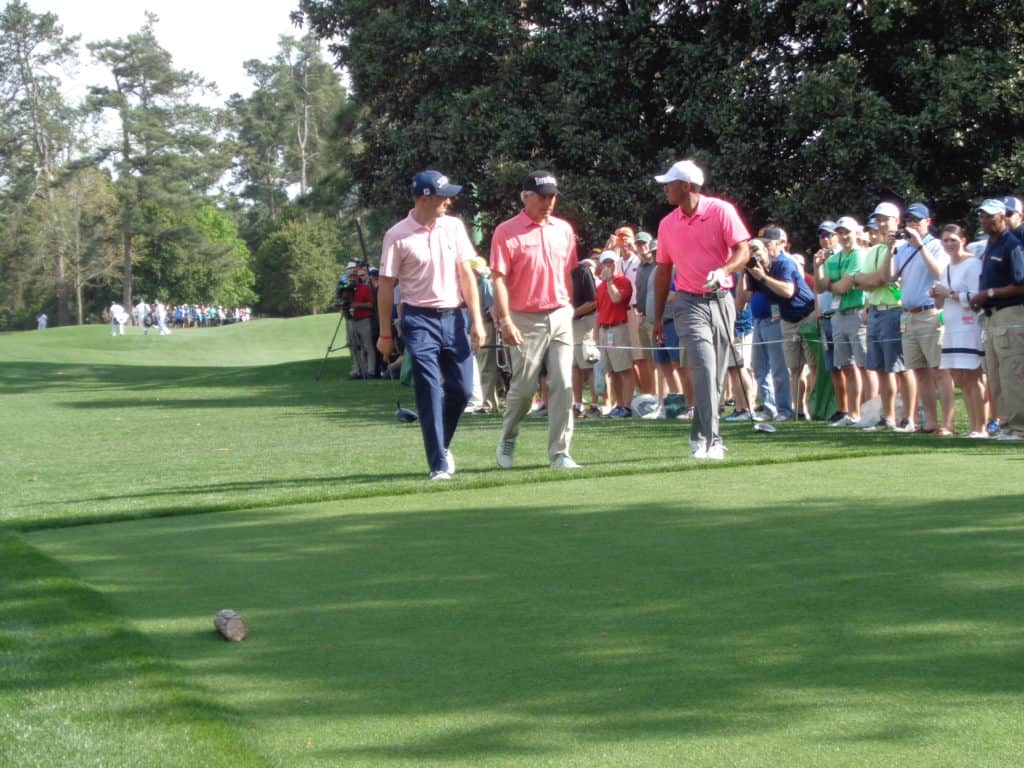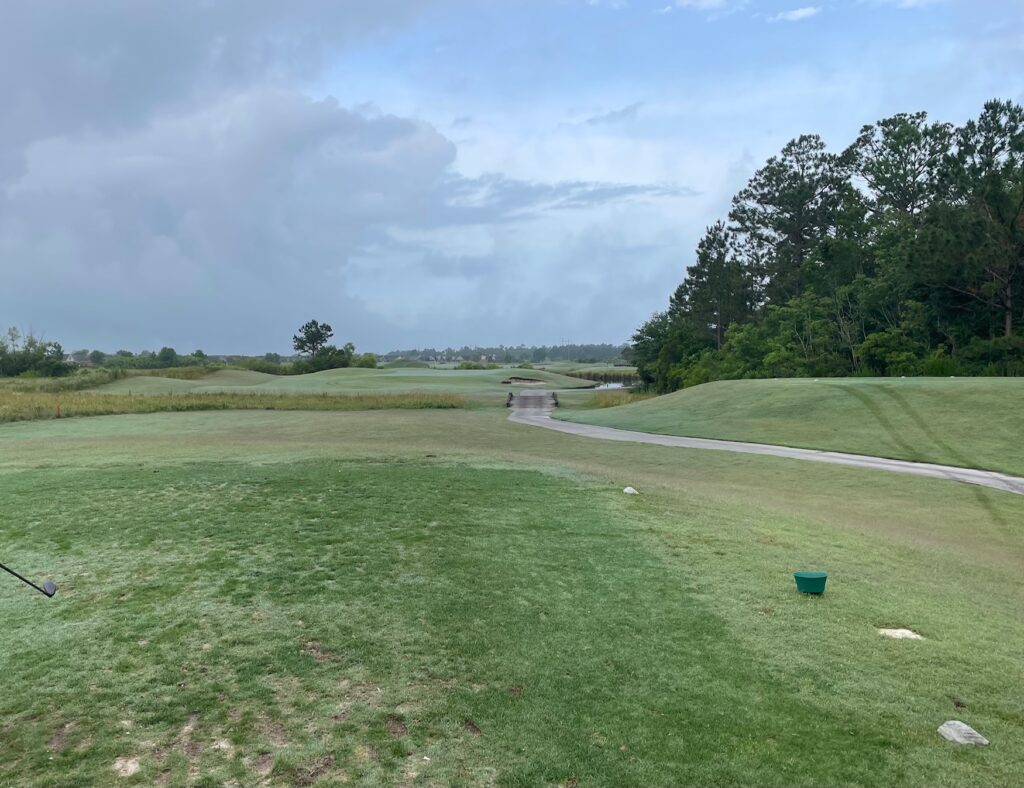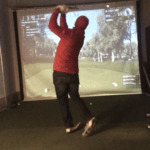We all want to get our driver dialed in because we know the importance of distance and keeping the ball in play. Distance matters in today’s game and we want to maximize our distance, especially with the right equipment settings.
The good news is that drivers often come with adjustable lofts in today’s golf market, but there are still plenty of questions of which loft is best.
I have an adjustable driver and tested out the two different lofts at questions: 9 vs 10.5 Driver.
Goals: Determine if a 9 or 10.5 degree driver is best for my game and hope that this information can help others.
Process: Hit 5 drivers with each club on the 18th hole at Pebble Beach on my golf simulator.
Data: I was able to collect the following data: carry distance, total distance, ball speed, spin rate, and launch angle.
9 vs 10.5 Degree Driver: Test Results
9 Degree Driver Chart
| Shot Number | Carry Distance | Total Distance | Ball Speed | Spin Rate | Launch Angle | Shot Shape |
| 1 | 249 | 268 | 156 | 2408 | 9 | Draw |
| 2 | 259 | 275 | 155 | 2952 | 11 | Fade |
| 3 | 257 | 277 | 160 | 2764 | 9 | Draw |
| 4 | 261 | 278 | 161 | 2206 | 10 | Fade |
| 5 | 250 | 270 | 151 | 2738 | 11 | Straight |
| Averages | 255.2 | 273.6 | 156.6 | 2613.6 | 10 | NA |
10.5 Degree Driver Chart
| Shot Number | Carry Distance | Total Distance | Ball Speed | Spin Rate | Launch Angle | Shot Shape |
| 1 | 260 | 280 | 153 | 2615 | 13 | Straight |
| 2 | 255 | 272 | 155 | 2850 | 13 | Fade |
| 3 | 255 | 270 | 153 | 2326 | 11 | Draw |
| 4 | 253 | 270 | 154 | 2750 | 12 | Fade |
| 5 | 255 | 275 | 153 | 2494 | 12 | Draw |
| Averages | 255.6 | 273.4 | 153.6 | 2607 | 12.2 | NA |
9 vs. 10.5 Degree Driver: Final Results
- The total distance was within .2 yards of each other, even though my ball speed was 3 miles per hour faster with the 9 degree driver. This tells me that the extra launch on the 10.5 provides a bit of extra distance as the spin rates were both in the 2600 range on average. It might be worth adding some loft to my 9 degree driver to get some extra yardage as long as it didn’t hurt me in the wind.
- Pretty interesting that my spin rate average was 2613 with the 9 degree driver and 2607 with the 10.5 degree driver.
- With all 10 shots I was able to hit the ball in the fairway or the first cut off rough.

9 vs 10.5 Degree Driver: Distance
For the majority of golfers, the 10.5 degree driver will provide more distance due to the increased launch angle which provides additional carry even with potentially lower ball speeds.
To maximize the carry distance, the golfer is going to want to find the ideal launch angle with the ideal spin rate. My longest carry with the 10.5 degree driver was 260 yards with a 153 mph ball speed, a launch angle of 13 and a spin rate of 2615. With the 9 degree driver my furthest carry was 261, but it took a ball speed of 161 to carry it this far with a spin rate of 2206, this shot had a launch angle of 10 degrees.
If I could produce the 161 with a 13 degree launch with a spin rate in thethe 2500-2660 I might have my ideal launch and spin rate conditions.
How does loft affect the everyday golfer?
The mid to high handicap golfer with a slower swing speed will want the extra loft in a majority of the cases.
I play at a scratch level, which my 255 average carry distances reflects. Those with a higher handicap will frequently have a slower swing speed and would benefit from the extra loft and the higher launch angle.
The average golfer swings around 95 mph with the driver and has a driver distance of 221 yards.
| Handicap Range | Median Driver Distance Average |
| PGA Tour Professional | 275 Carry |
| Scratch | 251 |
| 0-5 | 244.6 |
| 6-10 | 231.3 |
| 11-15 | 220.4 |
| 16-20 | 210.3 |
| 21-25 | 201.9 |
| Total Average of 0-25 | 221 |
9 vs 10.5 Degree Driver: Ball Speed
The 9 degree driver produced an average of 156 mph ball speed, while the 10.5 degree driver only produced 153 mph ball speed.
What we can conclude from the test complete with the 9 vs 10.5 driver is that the combination of ball speed, spin rate and launch angle all are vital for carry and total distance. With the 9 degree driver I had a higher ball speed, but it didn’t produce more distance.
When we get down to the fine details such as loft setting, it is important to test out and see what is best for your game. I would highly recommend getting on a launch monitor to get your driver to the perfect setting for your game.
Related: How to increase ball speed in golf
9 vs 10.5 Degree Driver: Spin Rate
The spin rates were both the 2600 RPM range, so the loft did not impact the spin rates according to the data collected. Both drivers were equipped with a stiff shaft.
Spin rate will play a vital roll in maximizing your total distance. With the average ball speed of an amateur, not enough spin will take away distance, just like too much spin will take away distance. Getting that ideal spin rate is vital to maximizing your distance. The wrong spin rates could reduce the carry and total distance by as much as 20-30 yards.

9 vs 10.5 Degree Driver: Launch Angle
The launch angle played a role in the carry distance. The higher launch angle of 12 and 13 degrees with the 10.5 degree driver helped provide as much carry as the 9 degree driver in spite of 3 mph less ball speed. The 9 degree driver had a launch of 10 degrees and the 10.5 degree had a launch of 12 degrees.
The extra 2 degrees of launch was a major factor. I didn’t expect these results. Golfers should spend more time making sure the spin rate and launch angle are more optimum.
Related: Where can I use a Launch Monitor?
9 vs 10.5 Degree Driver: Accuracy
The accuracy was similar. I didn’t notice a difference with the accuracy between the 9 and 10.5 degree driver.
One thing that could impact overall accuracy is the wind. On a windy day, the 10.5 degree driver might be more difficult to control due to the higher launch angle. It could also impact distance both positively and negatively whether into the wind or with the wind.
The golfer might have to make a decision on extra yardage with extra loft resulting in a higher launch angle or keeping the ball more controlled and increasing accuracy.
Related: How to hit your driver longer and straighter
What’s The Difference Between a 9 and 10.5 Degree Driver?
The most significant difference will be the launch angle produced with the different lofted drivers. Those with a swing speed below 105-110 mph might benefit from the extra loft. Other factors such as tee height and angle of attack will impact the launch angle with different golfers.
Golfer have the benefit of adjustable drivers in today’s golf world and should get on a launch monitor to test the following factors:
- Ball Speed
- Spin Rate
- Launch Angle
Based on a golfer’s average ball speed, there is an ideal spin rate and launch angle that can maximize the speed.

Is a 9 or 10.5 Degree Driver Better?
It comes down to each individual golfer. To make a general statement, those with slower speeds (below 105 mph on average) should consider a 10.5 degree driver. Those with higher swing speeds might benefit from less loft.
Do Any Pros use A 9 Degree Driver?
- Tiger Woods
- Rory Mcilroy
Do Any Pros Use A 10.5 Degree Driver?
- Dustin Johnson
- Brooks Koepka
Is A 9 Degree Driver Harder to Hit?
For the golfer with a slower swing speed, they might lose distance from a lack of the proper launch angle. The golfer will hit the golf ball lower and lack the maximum carry distance. A club with less loft is generally more difficult to hit straighter as the lower amount of loft can produce more side spin as well.
The majority of amateurs could default to a 10.5 driver that is adjustable and then test out a bit lower and a bit higher to see what provides the optimum driving conditions as far as loft is concerned.
Which degree driver should I use?
Most golfers should start with a 10.5 degree driver and then adjust as needed. If you swing above 105 mph with the driver, a 9 degree might benefit your game. If your swing is below 105 mph, you should start with the 10.5 degree driver. Fortunately, most drivers in today’s golf market are adjustable which will give the golfer some flexibility to determine what is best for their game and their swing.
Related: How to calculate swing speed in golf
How Far Should You Hit a 9 Degree Driver?
The average amateur golfer hits their driver 221 yards. If you want to play at a scratch level, the stats show you should be around 251 yards on average. With every increase in distance, the golfer increases his or her chances of shooting lower scores and carrying a lower handicap.
Related: How to increase swing speed in golf
How Far Should You Hit a 10.5 Degree Driver?
The average amateur golfer hits their driver 221 yards. If you want to play at a scratch level, the stats show you should be around 251 yards on average. With every increase in distance, the golfer increases his or her chances of shooting lower scores and carrying a lower handicap.

9 vs 10.5 Degree Driver: Final Thoughts
With today’s golf technology, we are fortunate to have adjustable drivers. Golfers also have tools such as launch monitors, range finders, GPS watches and other tools that allow a golfer to figure out what equipment provides the best opportunity to score their best. These tools also help the golfer better manage their game once on the golf course.
Our recommendation is to consider launch monitors and other technology tools that helps the golfer dial in the proper clubs, carry distance and other key stats that will ensure the golfer is playing the best equipment for their game.
Related Posts:
- Old Drivers vs New Drivers
- Should I Shorten My Driver: One Golfer’s Experiment
- Average Driving Distance by Age
I am an amateur golfer on a journey to get better, enjoy the game as often as possible and share my passion and knowledge with others. I have coached high school golfers at a high level and have a great passion for the game and want to give back. I enjoy learning about the golf swing and am currently studying to be a certified professional golf instructor. Join me in our journey to get better everyday.

